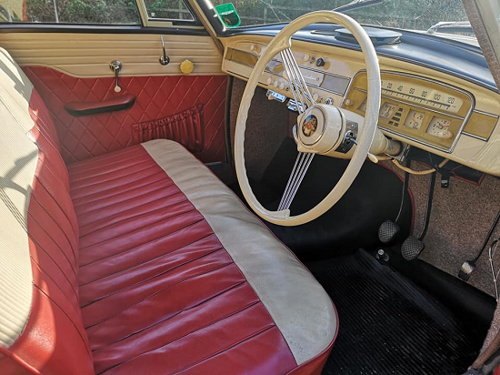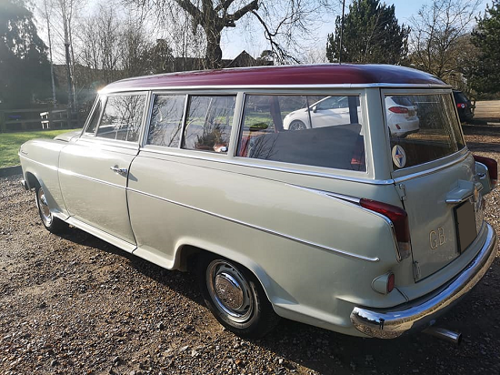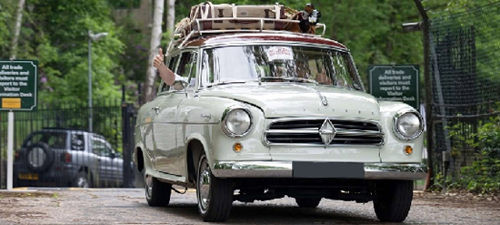MEET THE OWNER – IAIN BELL AND HIS BORGWARD ISABELLA COMBI
11 March 2025
In Britain 1960, a time when having two Custard Creams instead of one with your afternoon teas was deemed recklessly extravagant, ownership of a Borgward Isabella Combi was only for the few. According to the sales copy, it was: “A combination of everything that is best in Continental craftsmanship plus the experience gained in many racing successes in the 1,500cc class”.

It was also not a cheap proposition at £1,269 – the same price as a Ford Zodiac Mk. II Farnham Estate and over £100 more expensive than an Austin A99 Westminster. But those motorists with generous bank balances never regretted calling Borgward’s UK concessionaire, Metcalfe & Mundy Ltd., on FREmantle 5471 to arrange a test drive.
The industrialist Carl Borgward made three brands of cars at his Bremen factory after the Second World War - Goliath, Lloyd and Borgward Hansa. June 1954 saw the launch of the last-named's 1500; a saloon for the West German buyer who could afford 7,265 DM and who regarded the Mercedes-Benz 180 ‘Ponton’ as too staid. They might have also found the Ford Taunus 12M and the Opel Olympia Rekord as too quasi-Detroit.

As for the eventually famous name, Carl Borgward once noted of a Hansa 1500 prototype: “It does not matter what you put on it - you might as well call it Isabella”. In 1955, Borgward expanded the range with the Combi estate and the Cabriolet and dispensed with the ‘Hansa 1500’ grille badge in favour of ‘Isabella’.

In the UK, Motor Sport raved: “The Borgward Hansa 1500 Isabella is a car virtually without rivals”. Many years later, Brian Sewell wrote of his first encounter with the Borgward during his National Service:
to any young subaltern who had been driven to his prep school in his father’s Rover 12, or set off for the family holiday in Devon (then a 10-hour journey from London in a Wolseley), the Isabella was a revelation.
Yet, by September 1961, the last of 202,839 Isabellas departed the Bremen works. Carl Borgward once stated, “Five minutes before I make money, I spend it” and the firm had recently suffered from technical issues with their Lloyd Arabella economy car. Their flagship 2.3-litre P100 saloon proved expensive to develop and by 1959 the Germany army now only ordered new commercial vehicles from Daimler-Benz and Klöckner-Humboldt-Deutz. www.curbsideclassic.com argued:
The Quandt family, which had just taken control of BMW, used their considerable influence to ensure that the banks that had so far propped up Borgward would now close their line of credit.
The Bremen Senate took control of Borgward on the 4th February 1961. Two years earlier Carl Borgward rejected the idea of a Chrysler take-over while talks of a British Motor Corporation takeover or establishing a dealership/cooperative venture never reached fruition. Many Borgward owners noted that later in 1961, BMW displayed its 1500 ‘Neue Klasse’ at the Frankfurt Motor Show – a car very much in the former Isabella market sector.

As for Iain’s Combi, the red roof was his idea, and it gives the Borgward the sort of jaunty look of a Technicolor Conny Froboess musical. Power is from the more potent TS engine, which makes the estate somewhat of a Q-car. In the 1950s, your friendly local Borgward dealer could tell you the Isabella TS was faster than the six-cylinder BMW 501 ‘Baroque Angel’, Mercedes-Benz 220, and Opel Kapitän.
Iain says his Combi is: “Really smooth up to about 65 then gets a bit noisy. It is not a long-distance cruiser, but is okay for a 100 mile plus round trip. Some guys take theirs to Lake Como every year”. Sixty-five years after it departed the showroom, his Borgward is a car with vast levels of charm, from the ivory-coloured switchgear to the seat trim and the jukebox-like dashboard.
And if you wanted three-door, 1.5-litre sporting transport capable of transporting five passengers in style back in 1960 – there were literally no alternatives. As Carl Borgward said at the Isabella’s launch: “"A car has to be fashionable and have charm”.
With thanks to Iain Bell for his time and permission to use the images in this
blog.
